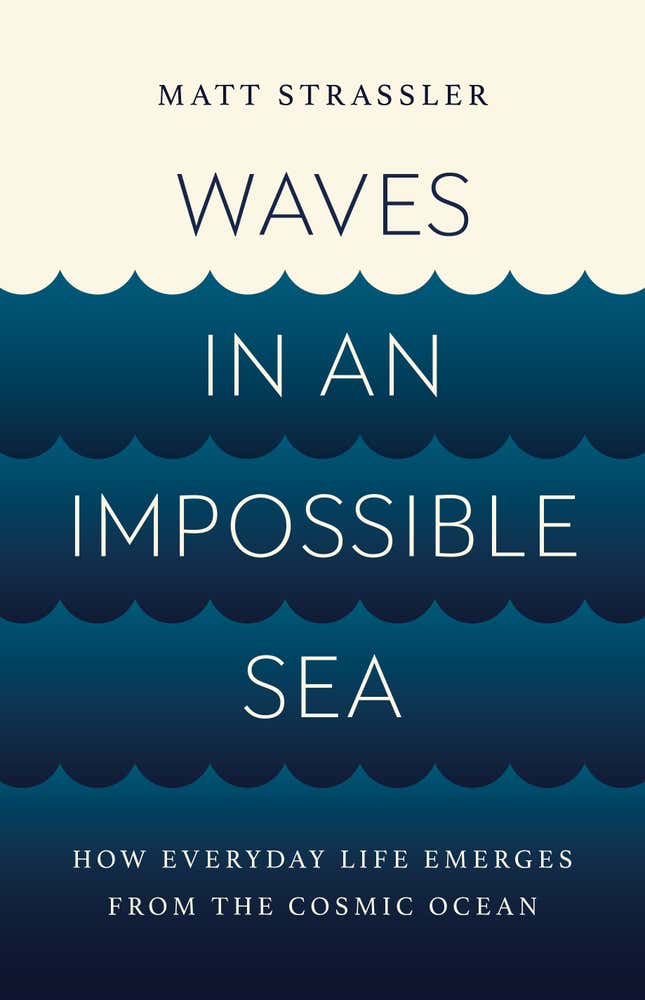Pondering the dimensions of the cosmos can really feel as should you’re peering over the sting of the brink; it may be daunting sufficient to make you need to flee to the comforts of working, commuting, and different quotidian endeavors. However in Waves in an Impossible Sea: How Everyday Life Emerges From the Cosmic Ocean, theoretical physicist and science communicator Matt Strassler doesn’t flinch within the face of the universe.
Revealed this week, Strassler’s guide expands on the concepts he’s explored for years on his weblog, Of Particular Significance. Readers are given a window into how the elemental legal guidelines that govern the universe form our each day experiences, and the way even essentially the most unique phenomena are usually not as alien to our day-to-day as they might appear.
Strassler just lately spoke with Gizmodo in regards to the guide’s origins and objectives. Beneath is our dialog, frivolously edited for readability.
Isaac Schultz, Gizmodo: There’s this fascinating dichotomy between the physics that’s taking place right here on Earth, what I name “wanting down,” and the physics that’s astronomical remark—“wanting up,” so to talk. And I used to be questioning you probably have thought of the identical factor, and the way you see that relationship.
Matt Strassler: One of many first issues I attempt to do within the guide is to interrupt that dichotomy down. As a result of we do have this tendency to consider the universe writ giant, this massive place that we stay in. After which there’s form of this tiny stuff occurring within us or within the supplies round us, and we don’t actually join them. However in fact, they’re profoundly linked. And, you understand, the universe—we used to name it name it outer house, and we consider it as principally a vacuum. It’s vacancy. However the stuff that’s within us can also be principally empty. It’s the identical vacancy. And so there is no such thing as a distinction between the outer-ness and the inner-ness. It’s the identical stuff doing lots of the similar issues. We’re not disconnected from that bigger universe. We’re really, in some sense, constructed from it. And so, that may be a message which I needed to have the ability to convey that I hope will change folks’s perspective on how they consider what it’s to be alive on this universe. That we don’t simply stay in it, however we develop from it in a really significant sense: not simply in a religious one, however in a really express physics sense.
Gizmodo: Yeah. Each time I’m barely stressed, I remind myself that I’m simply dying particles.
Strassler: We’re far more than that. However even once we say we’re particles, we’re lacking one thing. In English, by a particle we imply a bit localized factor, like a mud particle, that’s not linked to every part else. However once we perceive that what we name particles are literally little ripples, little waves within the fields of the universe, and the fields of the universe lengthen in all places. Throughout the whole universe. That’s a really completely different method of understanding what we’re constructed from. We’re not constructed from these little localized issues that transfer round in a universe. We’re constructed from ripples of a universe, and that may be a very completely different image.
Gizmodo: The crux of the guide is that this relationship between our trendy understanding of physics and human life, human existence as we expertise it. If you have been writing the guide, did you’ve a selected reader in thoughts? Who do you hope will, you understand, stumble throughout this title and decide it up?
Strassler: There are actually some readers who learn quite a lot of particle physics books already, and I hope that for them, what I’m offering is a method of one thing they already know. And specifically a method of understanding what the Higgs subject is all about. For these readers, it’s one thing they won’t have seen earlier than. However I additionally had in thoughts that there are quite a lot of mates of mine, relations, who don’t learn the books about particle physics exactly as a result of they’re quite obscure and sometimes appear irrelevant to their lives. The aim of this guide was to strip away, as a lot as doable, the issues that don’t matter to our bizarre each day existence and give attention to the issues that do. And attempt to inform a narrative, which actually doesn’t clarify all of particle physics by any means, however walks a path that takes the reader via all the issues that they would want to know to begin from scratch and are available out the tip with a way for a way the universe works and the way we slot in it.
I hope that I’ve supplied a path for a reader who’s curious however keen to take the time that it requires to grasp topics which might be that aren’t onerous simply because “physics is tough.” They’re onerous as a result of the universe is tough. It’s onerous for me. I can’t make it any simpler than it’s for me.
Gizmodo: That’s going to be the headline. “Physicist Confesses: ‘It’s Onerous For Me, Too.’”
Strassler: Okay. I’m proud of that.
Gizmodo: How did this guide emerge from the work that you just’ve been doing for years?
Strassler: I used to be a full-time tutorial scientist for an excellent 20 years. I had all the time been thinking about doing public outreach. However I had by no means had actually that a lot time being a full-time scientist. There was a sure second in my profession the place it wasn’t clear what I needed to do subsequent. And I began a weblog at that time. That was simply earlier than the anticipated after which precise discovery of what’s often known as the particle known as the Higgs boson.

The story of the Higgs particle is mostly a story of a subject often known as the Higgs subject, which is far more essential to us than the Higgs particle is. The Higgs subject impacts our lives in all kinds of how. However to grasp what the Higgs subject is and the way it does what it does, which is often what folks ask me, requires some understanding of each Einstein’s relativity and quantum physics. There wasn’t any approach to write the guide with out beginning with these issues. Despite the fact that explaining the Higgs subject was the unique motivation, I found that actually this can be a guide about what we all know at the moment primarily based on the final 125 years of scientific analysis in physics: what’s the massive image? How does all of it match collectively? And when you see that—when you perceive what particles really are and the way they emerge from relativity on the one hand and quantum physics on the opposite—then it’s not so onerous to clarify what the Higgs subject is. However it’s a must to spend two-thirds of the guide to get to that time.
Gizmodo: If you say to somebody that you just’re going to open with relativity and quantum physics, it’s a good way to finish the dialog.
Strassler: There may be that threat, proper? However that’s a part of why I actually opened with the questions on these topics that aren’t even clearly about them. They’re questions on each day life. And the actual fact is that these topics, which appear distant and really esoteric… they’re not. They’re deeply ingrained in bizarre human expertise. And that was actually what I needed to convey on this guide, that these quite strange-sounding topics that originate with Einstein and are made usually within the media and by scientists to look, “gee whiz”—and they’re—they’re greater than that. They’re the foundations of our each day experiences. And so I needed to deliver that sense of how essential these items are to us, to all of us.
Gizmodo: I feel that, scientists on the one hand and science communicators on the opposite, battle with this difficulty of, properly, it’s not going to be doable to convey all of the nuance in, say, a 400-word article. It’s simply not going to occur. It’s extra about writing the least-wrong factor than the most-right factor. You wrote a guide that grapples with complicated science. How have been you checking to ensure that this may really grok to the typical reader?
Strassler: It helps that I’ve had the weblog for 10 years. I even have some humility about how properly I’ve achieved this aim. That’s partly as a result of I do know these are tough topics. They’re not tough within the sense of that it’s a must to know arithmetic to grapple with them, however they’re tough within the sense that they’re simply unusual and tough for scientists to wrap their heads round. I do know that no matter strategies I’ve used within the guide, they’re going to work for some folks on some pages and for different folks on different pages. And so one of many issues that I’m doing with my web site is, I’m creating an entire wing of the web site whose aim is so as to add extra info. For instance, the figures, some can be animated on the web site to offer higher readability. The aim is to essentially clarify the science, and I’m not accomplished with that half.
Gizmodo: It’s been over ten years because the Higgs discovery. How do you go about penning this guide, fascinated with a post-Higgs world and making an attempt to handle the following massive query?
Strassler: In a way, the invention of the Higgs boson and the shortage of any quick discoveries thereafter over the following 10 years—leaving apart gravitational waves, which have been found in 2015—has put our understanding of the universe into a really fascinating place. It’s like having a brief story which is full however has all kinds of unfastened ends, which inserts into a bigger narrative which we don’t perceive. And so it’s form of an ideal second to explain what we all know and what we don’t. And actually break it into these two components.
There was a method by which, 10 years after the Higgs discovery, and in addition with the invention of gravitational waves, issues got here out kind of the best way we thought they’d. There have been no large surprises that utterly modified the best way we take into consideration issues. So it’s an excellent second to take inventory and to have a look at what we have now realized from Einstein’s relativity, on the one hand, and from quantum physics and all of its realization in particle physics on the opposite, and see the way it all suits collectively and attempt to actually describe that as a bundle.
To make use of a cliche, it’s actually extra like the tip of the start right here. We now have achieved one thing that’s actually outstanding prior to now 125 years. However we’re clearly additionally in some methods nonetheless originally of our understanding of how the universe actually works.
Gizmodo: One query that I used to be left with was mainly, the place is that this subsequent breakthrough going to return from? Do you’ve any specific choice for the number of great experiments occurring proper now in particle physics, in plans for gravitational wave observatories, all that jazz? What are you most enthusiastic about on the bodily horizon?
Strassler: All the best way as much as the invention of the Higgs boson, there was a path. However there’s all the time been one thing the place it’s clear that there are issues we have to know that in a roundabout way feed into the deepest questions on how the universe works. And for the primary time in 150 years, that’s now not true.
We don’t now have a transparent path. We now have many doable paths, and we don’t actually know which one is the perfect one. And that is a part of why there’s a lot controversy about particle physics proper now. It’s as a result of there are positively issues that we all know give us an honest likelihood of discovering one thing new. However we don’t have the form of confidence that we’d have had 30 years in the past or 60 years in the past, that the following wave of experiments positively will reply a number of of the questions that we have now.
So while you ask me what’s my most popular course, I would favor that the Massive Hadron Collider, which has 10 extra years to run, uncover one thing. As a result of that may make it loads simpler to know what to do subsequent. And the machine will run for 10 extra years, producing 10 instances as a lot information. So we do have that chance. However, I would love a clue from nature earlier than answering that query.
Gizmodo: You point out that the LHC is retains on ticking and you understand, the high-luminosity LHC is on the horizon. Do you anticipate that form of juicing the the collider will yield outcomes?
Strassler: I’m not an individual to specific optimism or pessimism about what nature could ship to us. I imply, I don’t assume I’ve the insights into nature to guess. However what I can say is that there’s an infinite quantity nonetheless to do, even with the information that we have now. It’s actually doable that there’s something to find within the current LHC information, along with the alternatives that having 10 instances that information will provide. So, I feel individuals are typically too fast to think about that, “oh properly, the LHC seemed. It’s not there. We’re accomplished.” No, no, no, no. The LHC produces an infinite pile of information, and each evaluation you do has to chop via that information in a selected method.
I wouldn’t say optimistic or pessimistic, however I might say I’m cognizant of the truth that there’s nonetheless an amazing quantity left to do on the LHC, and we must always positively not be writing it off in any respect at this level. What we will most likely say with some certainty is that the preferred concepts for what may be discovered on the Massive Hadron Collider are principally dominated out or unlikely at this level, however there are many issues, loads of examples in historical past the place the factor that was actually fascinating was one thing that no theoretical physicist had imagined. And we may should be actually imaginative about how we analyze the information on the LHC.
Trending Merchandise

Cooler Master MasterBox Q300L Micro-ATX Tower with Magnetic Design Dust Filter, Transparent Acrylic Side Panel…

ASUS TUF Gaming GT301 ZAKU II Edition ATX mid-Tower Compact case with Tempered Glass Side Panel, Honeycomb Front Panel…

ASUS TUF Gaming GT501 Mid-Tower Computer Case for up to EATX Motherboards with USB 3.0 Front Panel Cases GT501/GRY/WITH…

be quiet! Pure Base 500DX Black, Mid Tower ATX case, ARGB, 3 pre-installed Pure Wings 2, BGW37, tempered glass window

ASUS ROG Strix Helios GX601 White Edition RGB Mid-Tower Computer Case for ATX/EATX Motherboards with tempered glass…










